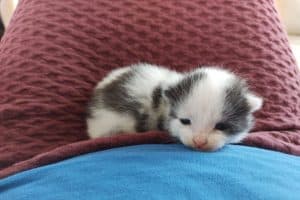Have you ever noticed that newborn kittens often have stunning blue eyes? Have you ever wondered why that is? In this blog post, we will explore the fascinating science behind why cats’ eyes are blue when they are born.
Genetic Factors
Have you ever wondered why cats’ eyes appear blue when they are born? Well, it all comes down to genetics. Just like in humans, eye color in cats is determined by genes passed down from their parents. In kittens, the genes responsible for eye color are not fully developed at birth, which is why blue eyes are so common in newborn cats.
A unique insight into this phenomenon is that the gene responsible for blue eyes in cats is a form of albinism. This means that the lack of pigment in the iris of kittens leads to the blue hue that is often observed in their eyes in the early stages of life.
Development Process
As cats grow, so do their eyes. The unique development process that newborn kittens undergo is fascinating because it directly impacts the color of their eyes. Initially, kittens are born with underdeveloped eyes that lack pigment, which is why blue eyes are prevalent.
In the weeks following birth, kittens’ eyes gradually start to develop more pigment as the melanin in their irises increases. This development process ultimately leads to the final eye color that your feline friend will have as they grow older.
Let’s not forget, cats are infamous for their beautiful blue eyes when they are young, which add to their undeniable charm and mystery. So the next time you look into the baby blues of a newborn kitten, remember that genetics and development processes play a pivotal role in giving them that unique and captivating gaze.
Melanin Levels
Blue eyes in cats at birth are a result of low melanin levels. Melanin, a pigment responsible for eye color, is not fully developed in newborn cats, leading to the blue hue. As kittens grow, melanin production increases, causing their eyes to gradually change color. So, those captivating blue eyes are just a temporary feature as the kittens develop.
Furthermore, melanin plays a crucial role in protecting the eyes from harmful UV rays. Cats with lighter eye colors, such as blue or green, may be more sensitive to light due to lower melanin levels. This makes it important for their eyes to eventually develop more pigment for better eye protection.
Evolutionary Adaptations
Cats are born with blue eyes as an evolutionary advantage. In the wild, newborn animals often have less developed features to help them blend in with their surroundings, making them less noticeable to predators. Blue eyes in kittens might serve to make them appear less threatening or more vulnerable, increasing their chances of survival.
Additionally, blue eyes are more visible in low light, which can help a mother cat locate her kittens in dimly lit environments. This trait can be crucial for kitten survival, ensuring that they stay close to their mother for warmth, protection, and nourishment. As the kittens grow and their eyes develop more pigment, this characteristic may no longer be as essential for their survival.
Extra Tip:
An interesting evolutionary theory suggests that blue eyes help establish a stronger bond between a kitten and its mother. The eye contact between them can trigger maternal instincts and promote nurturing behavior, ultimately benefiting the kitten’s wellbeing.
Common Misconceptions
Blue-eyed cats are often associated with being rare or inherently unique compared to cats with other eye colors. However, it’s important to debunk the myth that blue-eyed cats are always special or exotic. While some breeds do tend to have blue eyes more frequently, such as Siamese or Ragdoll cats, this eye color is simply a result of genetics and not an indicator of rarity or special qualities in the cat.
Another common misconception is that all kittens are born with blue eyes regardless of breed or genetic background. While it is true that many kittens are born with blue eyes, this does not hold true for all cats. Some kittens are born with other eye colors, such as green or yellow. The blue eyes in kittens are due to the lack of melanin in their irises, which gradually develops as they grow.
It’s important to understand that eye color in cats, just like in humans, is determined by genetics and can vary widely within a breed. So, while blue-eyed cats may have a certain mystique, it’s essential to recognize that their eye color is simply a result of genetic factors rather than any inherent special qualities.
Eye Color Changes
When kittens are born, their eyes are not yet fully developed, and they lack melanin in their irises, leading to the appearance of blue eyes. As they grow and their bodies produce melanin, the pigmentation in their irises increases, causing a transformation in eye color from blue to their permanent shade.
The process of eye color change in kittens can be fascinating to witness. Typically, by the time a kitten is around 3 to 4 months old, their eye color begins to settle into its permanent hue. This change occurs as melanin production increases and the eye pigment develops fully. For some cats, this shift might happen sooner or later, depending on their genetics.
It’s important to note that not all kittens’ eyes will change color in the same way or at the same pace. Some kittens may retain their blue eyes for a longer period before transitioning to their final eye color. This gradual shift in eye color is a natural and normal part of a kitten’s development as they grow into adulthood.
Key Insights:
- Kittens are born with blue eyes due to the lack of melanin in their irises.
- As kittens grow and melanin production increases, their eye color changes to its permanent shade.
- The process of eye color change typically begins around 3 to 4 months of age.
Health Implications
Did you know that a cat’s eye color can sometimes be an indicator of underlying health issues? While most cats are born with blue eyes which later change to their permanent color, certain health conditions can cause a cat’s eyes to appear blue even into adulthood. If you notice a sudden change in your cat’s eye color or if their eyes seem cloudy, watery, or inflamed, it’s essential to consult with your veterinarian. These symptoms could be a sign of an eye infection, injury, or even a more serious health issue such as cataracts or glaucoma. Regular check-ups and prompt attention to any changes in your cat’s eye color can help ensure your furry friend’s eyes stay healthy and vibrant for years to come.
Fun Facts
Ever wondered why cats have such mesmerizing eyes? Not only do they come in a variety of stunning colors like green, gold, amber, blue, and hazel, but they also possess unique features like vertical pupils that help them see in low light. Cat eyes are also equipped with a specialized reflective layer called the tapetum lucidum, which enhances their night vision and gives them that eerie ‘glowing’ effect in the dark. Plus, did you know that domestic cats have a wider range of eye colors compared to their wild counterparts? So next time you gaze into your cat’s captivating eyes, remember that those vibrant hues and intriguing shapes are just a few of the many reasons why they’re such fascinating creatures.
Alex, a passionate animal lover, has experience in training and understanding animal behavior. As a proud pet parent to two dogs and three cats, he founded AnimalReport.net to share insights from animal experts and expand his knowledge of the animal kingdom.




